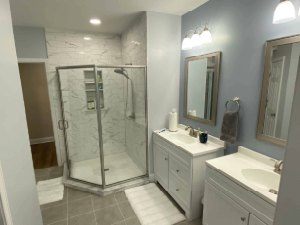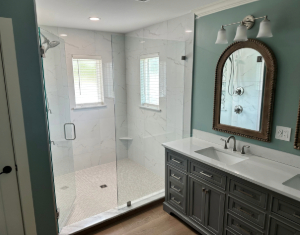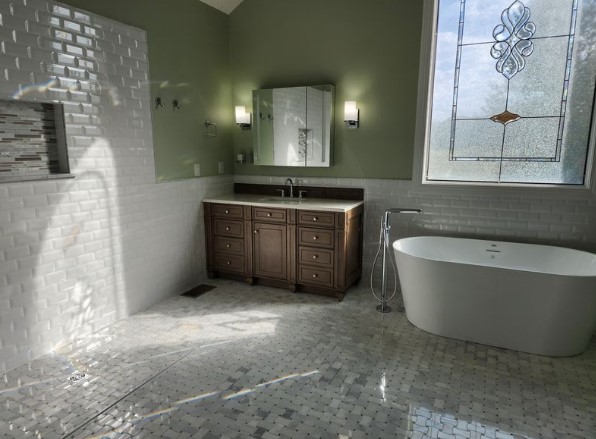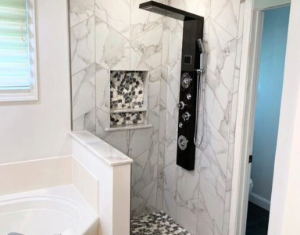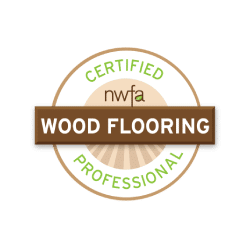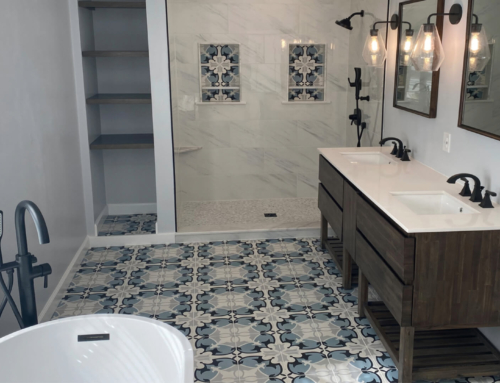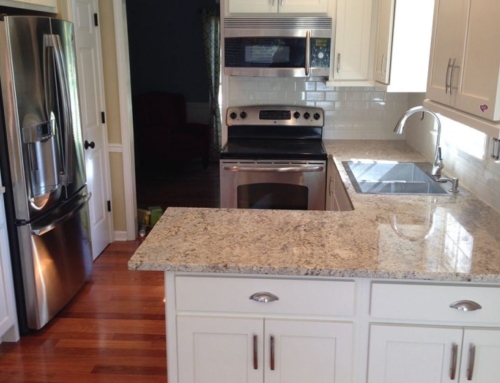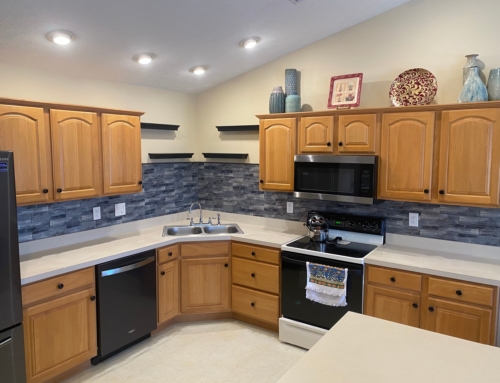Our human ancestors began cooking food outdoors in large pits over raging fires, not unlike the weekend warriors you’ll see at state parks across the country today. But as humans evolved, so did our cooking skills, and the art and craft of preparing delicious (and nutritious) food moved indoors.
Cooking outdoors requires little concern for messes and cleanup. Any spilled food will be snapped up by hungry animals, and any stains or messes will be washed away with the next rain. But indoors? That’s a whole other story.
Enter the kitchen backsplash, humble protector of interior walls.
The first backsplashes were utilitarian in nature. Made of glass or ceramic tile—whichever was available and—more importantly—cheaper at the time, the earliest backsplashes were only about four inches tall, just enough to catch any water, grease or food that “splashed” (hence the name) out of the cooking implements and onto the wall.
Over time, kitchen backsplashes grew more elaborate and taller. The materials became costlier, and prettier, and rather than simply protect the area behind just the stove, backsplashes now flank entire countertops.
Nowadays it’s not uncommon to find backsplashes made of marble, granite, metal or even bamboo, that stretch high above the stove and countertops, creating an ornamental as well as functional element of a gorgeous kitchen design.
Backsplashes are one of the most prominent ways to personalize the heart of your home and provide a seamless transition from countertop to wall. A kitchen without a backsplash is like a picture without a frame—it completes the space and adds the perfect finishing touch to tie your busiest room together.
If your kitchen backsplash has become cracked (in the case of tile), scratched or dinged (in the case of metal) or your kitchen was never build with this functional and beautiful design element to begin with, there are just a few simple considerations you need to make to find the perfect material and design for your home.
Compliment the Countertop
A big mistake many homeowners unwittingly make is selecting a kitchen backsplash that clashes with their countertops or cabinets. Take advantage of the many samples available at the big box stores, or, better yet, look over the large sample selection a professional installer will bring when you schedule an estimate with them.
There are limitless combinations of colors, materials, shapes and sizes available for your kitchen backsplash, and the easiest way to find the best fit for your kitchen is to compare samples with your counters and cabinets.
A Material World
There are five distinct materials used for creating gorgeous backsplashes, each with its own pros and cons. Which one you choose will be the result of a combination of personal taste, budget, and the style and materials used to construct your floor and countertops.
Ceramic– Ceramic was one of the first materials used in kitchen backsplashes, and it remains just as popular today as it was in your great-great-greatgrandparents’ time. It’s relatively durable (kitchen backsplashes don’t take a whole lot of abuse), easy to wipe down, and can vary in price from the very expensive (porcelain, a sturdier type of ceramic, is usually on the higher end of the price scale) to the eminently economical. It comes in as many shapes, sizes and colors as the human imagination can come up with, making it the most versatile material on the market for matching the design and color pattern already in your kitchen.
Glass– Humans have been embedding glass tiles in mortar for centuries as a form of mural making. Whether you’d like a graphic depiction of Cortéz’s conquering of the Aztecs or a more abstract design using your favorite color palate, glass tiles may be the design choice for you. Easier to replace if cracked or broken than large tiles, glass tiles also lend a “vintage” look to any “retro” kitchen design. For a more contemporary glass look, larger back-painted glass panels are as easy on the eye as they are to clean. They work especially well in smaller kitchens, where the natural reflection from the glass creates the illusion of space.
Natural Stone – If you’re already planning to replace your countertop with natural stone slabs, one luxurious option is to flank the walls with a matching backsplash. This is usually only done in conjunction with the countertops, to ensure the stones come from the same lot and therefore have similar veining and patterning. Otherwise, natural stone tiles, from the teeny tiny all the way up are available if your tastes and budget call for them.
Metal– Metal tiles and panels have become more popular in recent years, as clean lines and an industrial color palate come more into vogue. If you’re going for a more antiquated look, textured metal foil panels brighten a room with their reflective qualities, are incredibly easy to clean, don’t crack or break, and small dings and dents aren’t usually noticeable amid their intricate patterns.
Polished Wood or Wood-like panels– Usually where there’s water there should notalso be wood. Wood is water absorbent, and constant exposure to dampness and humidity can cause expansion, warping, and all kinds of undesirable effects. These days, all kinds of synthetics (polyurethanes, plastics, vinyl, etc.) can mimic the look and feel of polished wood, without the downside. If true rustic is your design goal, nothing yells it louder than wood.
Mix or Match Materials
Whether you’re going for complimentary or contrasting design (both can work equally well, depending on your style), you’ll want to either match or creatively mismatch the material used for your backsplash with your countertops and floors.
Marble floors and granite counter tops? You’ll probably want a natural stone backsplash to accentuate your kitchen’s opulence.
Square ceramic floor tiles and Formica counters? How about rectangular subway tiles for a little contrast while still maintaining consistency of materials?
Luxury vinyl plank flooring and faux-woodgrain countertops? Textured coper tiles would complete the modern rustic look with flair.
Looking for something truly unique? A skilled craftsman can design and build a custom mural, using either small glass square tiles or a material of your choosing.
Value Added Equals Value Gained
It may seem obvious, but the more value you put into your home, the more value it gains—and retains. Actually, as the growth of the housing market outpaces inflation, you could see a tenfold return on investment if given enough time. Even seemingly small upgrades, like a designer kitchen backsplash, could yield hundreds or even thousands in returns down the road.
Call or email Flooring Masters & Professional Remodelers today for a free consultation. We know you only want the best in flooring. That’s why it’s important to hire the best in the business, and at Flooring Masters & Professional Remodelers, we can guarantee you that’s us.
Flooring Masters & Professional Remodelers have been flooring and remodeling Kentuckiana for over 30 years. Our certified installers have the ingenuity and know-how to assist you in choosing the perfect floors for your home. Don’t take matters into your own hands—let us guide your next project.

